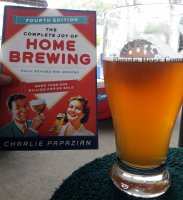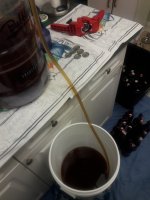Brews-n-Blues
Well-Known Member
- Joined
- Jun 22, 2020
- Messages
- 72
- Reaction score
- 13
Hello out there to all you Brewers!
HAPPY THANKSGIVING to all of you!
So I have a question about the carbonation process?
I have Brewed 2 different 5 gallon Beer kits so far.
The first was an English Porter and the second was a favorite style of mine,
a Hefeweizen! I'm having the same problem with both styles?
The carbonation levels?
I did it exactly how it instructs in the Brewer's Best kit? I dissolve the priming sugar in heated water for the instructed time. I then pour this sugar solution, after cooling, into the bottling bucket. Then I Siphon the Beer into the bottling bucket, so that it swirls, stirs and mixes the liquid equally, before bottling? I then store all the bottles inside a large dark tote,
the "Bomb-Shelter" at room temp. (73°),
for 2 to 3 weeks. I try one and if it's carbonated to my liking, I put the rest in the refrigerator to share and enjoy!
I've noticed on both kits, that the carbonation level is all over the place!?
One will be perfect, one will be OK and then one will be flat?? The flavors are pretty much on mark, with a little variance, I'm thinking because of the lack of carbonation? But, thankfully I haven't had any bottle-bombs!
I don't understand why the levels have been radically different? Some seem to not have any carbonation at all?? Flat?
Does the cooling temp have anything to do with ruining the carbonation level?
Should I not put all the bottles in the fridg, if the one tester is perfect?
The guy at the Brew supply shop said that it's because I'm using the priming sugar in the kit? He said that he always uses the priming drops, "sold seperately" in a bag, that you put one drop in every bottle, then cap.
Should I use this method instead of the priming sugar that comes in the kits?
Or should I just bite the "cost bullet" and start kegging and force carbonating?
I really want to learn this process?
I hate going through this "hit-or-miss" stuff when popping a Beer!?
It can be such a let down?
Any info on this is much appreciated!
Have a great weekend!
Cheers to the Craft!


HAPPY THANKSGIVING to all of you!
So I have a question about the carbonation process?
I have Brewed 2 different 5 gallon Beer kits so far.
The first was an English Porter and the second was a favorite style of mine,
a Hefeweizen! I'm having the same problem with both styles?
The carbonation levels?
I did it exactly how it instructs in the Brewer's Best kit? I dissolve the priming sugar in heated water for the instructed time. I then pour this sugar solution, after cooling, into the bottling bucket. Then I Siphon the Beer into the bottling bucket, so that it swirls, stirs and mixes the liquid equally, before bottling? I then store all the bottles inside a large dark tote,
the "Bomb-Shelter" at room temp. (73°),
for 2 to 3 weeks. I try one and if it's carbonated to my liking, I put the rest in the refrigerator to share and enjoy!
I've noticed on both kits, that the carbonation level is all over the place!?
One will be perfect, one will be OK and then one will be flat?? The flavors are pretty much on mark, with a little variance, I'm thinking because of the lack of carbonation? But, thankfully I haven't had any bottle-bombs!
I don't understand why the levels have been radically different? Some seem to not have any carbonation at all?? Flat?
Does the cooling temp have anything to do with ruining the carbonation level?
Should I not put all the bottles in the fridg, if the one tester is perfect?
The guy at the Brew supply shop said that it's because I'm using the priming sugar in the kit? He said that he always uses the priming drops, "sold seperately" in a bag, that you put one drop in every bottle, then cap.
Should I use this method instead of the priming sugar that comes in the kits?
Or should I just bite the "cost bullet" and start kegging and force carbonating?
I really want to learn this process?
I hate going through this "hit-or-miss" stuff when popping a Beer!?
It can be such a let down?
Any info on this is much appreciated!
Have a great weekend!
Cheers to the Craft!

























































![Craft A Brew - Safale S-04 Dry Yeast - Fermentis - English Ale Dry Yeast - For English and American Ales and Hard Apple Ciders - Ingredients for Home Brewing - Beer Making Supplies - [1 Pack]](https://m.media-amazon.com/images/I/41fVGNh6JfL._SL500_.jpg)




